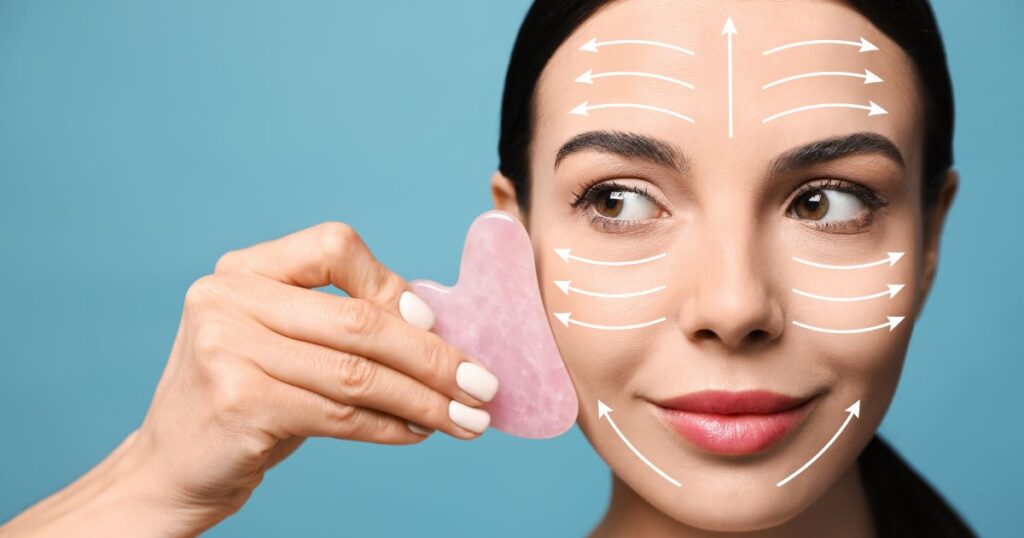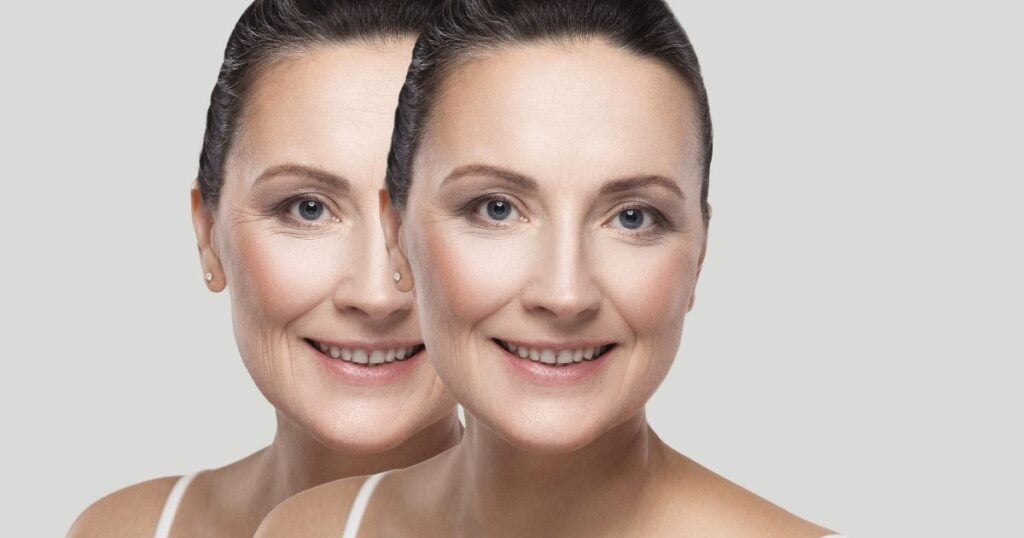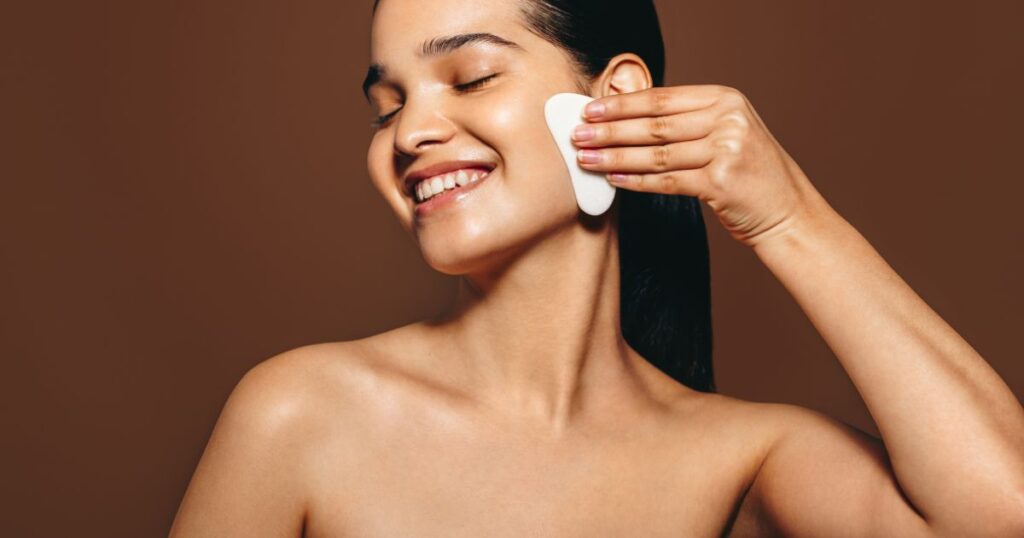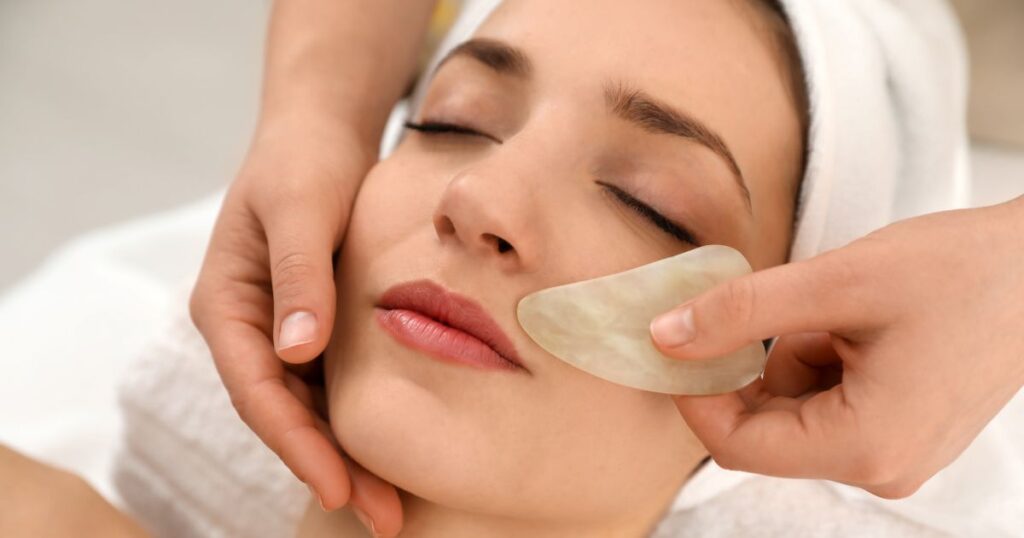In a world where beauty and wellness increasingly intersect with the pursuit of natural and sustainable practices, gua sha emerges as a beacon of holistic self-care. This ancient Chinese technique, once a guarded secret of traditional Chinese medicine, has found its way into the heart of the clean beauty movement, captivating enthusiasts with its simplicity and profound benefits.
Gua sha treatment, characterized by the gentle scraping of the skin with beautifully crafted stone tools, offers more than just superficial beauty enhancements. It stands at the crossroads of health and aesthetics, promoting lymphatic drainage, improving circulation, reducing chronic pain, and enhancing skin appearance—all key to achieving that coveted natural glow.
But the appeal of gua sha therapy appeal goes beyond its physical benefits. It embodies the clean beauty movement’s core principles: non-toxicity, sustainability, and a holistic approach to wellness. By utilizing natural materials like jade and rose quartz, gua sha aligns with the ethos of those seeking beauty routines that honor the body and the planet.
Table of Contents - Click to Go
The History and Significance of Gua Sha in Clean Beauty
Gua sha’s journey from traditional Chinese medicine to a modern beauty staple is a fascinating tale of tradition meeting innovation.
Origins and Evolution of Gua Sha Treatment
- Ancient Roots: Gua sha’s origins can be traced back to traditional Chinese medicine, where it was initially used to relieve pain and treat ailments through pressurized scraping of the skin.
- Technique Over Time: Historically, practitioners used tools made from various natural materials, including jade, bone, and horn, believing these elements could offer unique healing properties.
Alignment with Clean Beauty
- Natural Tools: In line with clean beauty’s emphasis on non-toxic and sustainable practices, gua sha tools are made from natural stones such as jade or rose quartz.
- Non-invasive Beauty: Gua sha advocates for gentle, non-invasive methods for pain relief and to enhance beauty and wellness, avoiding harsh chemicals and procedures.
Timeless Benefits
Gua sha remains celebrated for its ability to:
- Improve blood circulation
- Improve the immune system
- Relieve joint pain
- Reduce chronic neck pain and chronic headaches
- Relieve symptoms of autoimmune disorders
- Reduce perimenopausal symptoms
- Enhance lymphatic drainage, leading to reduced puffiness
- Promote natural healing processes, resulting in a brighter, clearer complexion
The resurgence of gua sha in contemporary beauty routines is a testament to the timeless appeal and effectiveness of natural, non-invasive beauty techniques.
How to Use Gua Sha: A Step-by-Step Guide for Clean Beauty Practitioners

Gua sha involves scraping the skin with a smooth-edged instrument. Facial gua sha may use a facial lifting tool or facial rollers to enhance the circulation of surface tissue on the face.
Embracing gua sha therapy in your beauty regimen can transform your skin’s appearance and overall well-being.
Choosing Your Gua Sha Tool
- Material Matters: Opt for a jade, rose quartz, or amethyst massage tool. Each stone has unique properties—jade for its balancing effect, rose quartz for promoting love and healing, and amethyst for its calming energy.
- Shape and Size: Select a tool that fits comfortably in your hand, with edges designed to contour to the different areas of your face and neck.
Preparing Your Skin
- Cleanse: Start with a clean face to ensure your skin is free of any products that could hinder the gua sha’s glide.
- Lubricate: Apply a clean, natural oil like coconut oil or olive oil to provide a smooth surface for the gua sha to glide over. This also helps with absorption of the oil’s nutrients.
The Gua Sha Technique
- Angle: Hold the massage tool at a 15-30 degree angle to your skin, using light pressure and gentle contact.
- Direction: Always move upwards and outwards on the skin’s surface to encourage lymphatic drainage and lift the skin.
- Neck: Start with the neck, moving from the base upwards to clear the lymphatic pathways.
- Jawline and Cheeks: From the center of the chin, move the facial lifting tool along the jawline and up the cheeks.
- Under-Eye: Gently glide from the inner corner of the eye outwards to reduce puffiness.
- Forehead: Sweep upwards from the eyebrows to the hairline.
Frequency and Duration
- For optimal results, incorporate gua sha massage into your routine 2-3 times a week.
- Each session should last about 5-10 minutes.
Safety Tips and Common Mistakes
- Gentle Pressure: Avoid applying too much force to prevent bruising.
- Consistency Over Intensity: Regular, gentle use is more effective than sporadic, intense sessions.
- Clean Your Tool: Always clean your gua sha tool with mild soap and water after use to maintain hygiene.
Gua Sha Before and After: Transformations That Speak Volumes

Visual and Physical Benefits
- Improved Skin Texture: Many report smoother, more radiant skin, thanks to enhanced circulation and exfoliation.
- Reduced Puffiness: The lymphatic drainage effects of gua sha massage contribute to a more contoured, less swollen appearance, particularly around the eyes and cheeks.
- Contouring Effects: Regular gua sha use can define jawlines and cheekbones, offering a natural lift to the face.
Studies suggest that the increased blood flow from the gentle massage techniques used in gua sha can promote healing and aid in the skin’s natural regeneration processes, leading to a more youthful appearance over time.
Myth Debunking
- No Instant Fixes: Gua sha is not a one-time solution but rather a practice that yields results over consistent use.
- For All Skin Types: Though gentle, it’s a universally beneficial practice when performed correctly, even for sensitive skin.
Incorporating Gua Sha into Your Clean Beauty Routine

Integrating gua sha into your daily or weekly beauty routine can seem daunting at first, but with a few simple steps, it becomes an effortless and enjoyable ritual that enhances your overall skin health and complements other clean beauty practices.
- Morning or Evening: Decide whether you prefer a rejuvenating morning session to awaken your skin or a relaxing evening routine to unwind and aid in the skin’s overnight healing process.
- Pair with Natural Skincare: Use gua sha after applying your favorite clean, organic serums or oils to help these products penetrate more deeply and effectively.
- Mindful Moments: Treat your gua sha routine as a time for mindfulness and self-care, focusing on the sensations and the nurturing aspect of the practice.
Synergy with Clean Beauty Practices
- Complementary Techniques: Incorporate gua sha alongside other natural beauty rituals like facial steaming or masking for enhanced effects.
- Sustainability: Choose gua sha tools made from ethically sourced materials and maintain them well to ensure they last, aligning with the sustainability goals of clean beauty.
Long-Term Benefits
- Consistent use of gua sha can lead to lasting improvements in skin health, such as enhanced elasticity, reduced appearance of fine lines, and a more radiant complexion.
- Beyond the skin, gua sha promotes a holistic sense of wellness, encouraging relaxation and stress reduction which is integral to overall beauty.
Tips for Incorporation
- Start Slowly: Begin with once a week, gradually increasing frequency as you become more comfortable with the technique.
- Listen to Your Skin: Pay attention to how your skin responds and adjust frequency and pressure accordingly.
- Be Patient: The most profound benefits of gua sha come with time and regular practice.
Incorporating gua sha into your clean beauty routine not only enhances your skincare routine but also aligns with the principles of mindfulness, sustainability, and holistic health. It’s a simple practice with profound benefits, seamlessly fitting into the clean beauty ethos.
Embrace The Ancient Wisdom of Gua Sha

Gua sha stands as a testament to the power of natural, holistic wellness practices, seamlessly blending the wisdom of ancient Chinese medicine with the principles of the clean beauty movement.
Let’s embrace gua sha as a bridge between ancient healing and modern self-care, inviting its myriad benefits into our lives. We encourage you to share your own experiences or dive deeper into the world of clean beauty, continuing to explore practices that honor both your body and the environment.
FAQs: Everything You Need to Know About Gua Sha
Can gua sha cause bruising or harm the skin?
With gentle pressure and proper technique, gua sha is unlikely to cause bruising. Always start softly and increase pressure only as comfortable. If you are taking blood thinners, consult with your doctor before engaging in gua sha therapy.
How often should I practice gua sha?
For best results, incorporate gua sha 2-3 times a week into your routine. Listen to your skin’s needs and adjust accordingly.
What type of gua sha stone is best for me?
Choose a stone based on personal preference and skin sensitivity. Jade is cooling and great for sensitive skin, while rose quartz promotes healing and love.
Can gua sha help with acne or sensitive skin?
Yes, gua sha can improve circulation and promote lymphatic drainage, which may help reduce inflammation. However, avoid active acne to prevent irritation.
How do I clean and maintain my gua sha tool?
Clean your gua sha tool with gentle soap and water after each use. Dry thoroughly before storing to maintain its integrity.
Is gua sha suitable for all ages?
Absolutely. Gua sha is a gentle, non-invasive practice beneficial for adults of all ages seeking to improve their skin health and wellness.
Can I use gua sha if I have fillers or botox?
It’s best to consult with your healthcare provider, but generally, it’s recommended to avoid direct pressure on areas with fillers or botox for a certain period.
Will gua sha replace my regular skincare routine?
Gua sha is a complement to your skincare routine, enhancing product absorption and benefits, not a replacement for foundational skincare practices.

